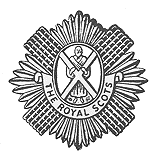
The Royal Scots , once known as the Royal Regiment of Foot, was the oldest and most senior infantry regiment of the line of the British Army, having been raised in 1633 during the reign of Charles I of Scotland. The regiment existed continuously until 2006, when it amalgamated with the King's Own Scottish Borderers to become the Royal Scots Borderers, which merged with the Royal Highland Fusiliers, the Black Watch, the Highlanders and the Argyll and Sutherland Highlanders to form the Royal Regiment of Scotland.

The 52nd Lowland Volunteers is a battalion in the British Army's Army Reserve or reserve force in the Scottish Lowlands, forming the 6th Battalion of the Royal Regiment of Scotland, also known as 6 SCOTS. Due to its erstwhile association with the 1st Regiment of Foot, it is the senior Reserve line infantry battalion in the British Army. It is one of two Reserve battalions in the Royal Regiment of Scotland, along with 51st Highland, a similar unit located in the Scottish Highlands.

The 51st Highland Volunteers is a battalion in the British Army's Army Reserve or reserve force in the Scottish Highlands, forming the 7th Battalion of the Royal Regiment of Scotland, also known as 7 SCOTS. It is one of two Reserve battalions in the Royal Regiment of Scotland, along with 52nd Lowland, a similar unit located in the Scottish Lowlands.
The Queen's Edinburgh Rifles was a brigade of Rifle Volunteers raised in the City of Edinburgh in 1859. It later formed two battalions of the Royal Scots, which fought in World War I at Gallipoli, in Palestine and on the Western Front. The two battalions combined between the world wars before being converted into an air defence regiment of the Royal Artillery (RA). This served in Anti-Aircraft Command during World War II and continued in the postwar Territorial Army (TA) until 1961, when its successors were converted into Royal Engineers (RE).

The Army Cyclist Corps was a corps of the British Army active during the First World War, and controlling the Army's bicycle infantry.

Brigadier-General Sir Robert Cranston was a Scottish military officer who served as Lord Provost of Edinburgh from 1903 to 1906. He had an illustrious military career largely with the Volunteer Force.

The Dalmeny Street drill hall in Edinburgh, was built as a military drill hall in 1901, and between 2003 and 2010 was redeveloped as community arts and education centre under the name TheOut of the Blue Drill Hall. The drill hall is protected as a category A listed building.

The 156th Brigade was an infantry brigade formation of the British Army. The brigade saw active service in both World War I and World War II with the 52nd (Lowland) Division.

The 155th Brigade was an infantry brigade of the British Army that saw active service in both World War I and World War II. Assigned to the 52nd (Lowland) Division, the brigade saw active service in the Middle East and on the Western Front during the First World War. During the Second World War, now the 155th Infantry Brigade, it continued to serve with the 52nd Division in Operation Dynamo, and later in North-western Europe from late 1944 until May 1945.
221st Mixed Brigade was a Scottish Home Service formation of the British Army that served under various titles throughout World War I.

The Highland Cyclist Battalion was a bicycle infantry battalion of the Territorial Force, part of the British Army. Formed as part of the Volunteer Force in 1860, it became a Volunteer Battalion of the Black Watch in 1881. In 1909 it became an independent unit and served in the United Kingdom throughout the First World War. In 1920 it was converted as part of the Highland Divisional Signals.

The London Rifle Brigade was a volunteer regiment of the British Army.
The Glasgow Brigade was an infantry formation of Britain's Volunteer Force from 1890 to 1902. It was the forerunner of two formations of the Territorial Force that saw service in both World Wars.
The Forth Brigade was a Scottish infantry formation of Britain's Volunteer Force from 1888 to 1902.
The 1st Linlithgowshire Rifle Volunteers was a Scottish unit of Britain's Volunteer Force raised in Linlithgow in 1860. It later became a cyclist battalion of the Royal Scots, which served in Home Defence and saw action in the North Russia Intervention force during World War I. Between the wars it was reduced to company strength, but just before World War II it was converted into an anti-aircraft (AA) regiment of the Royal Artillery (RA). This served in Anti-Aircraft Command during the Blitz and later distinguished itself in the Siege of Tobruk. It fought through the Italian Campaign and its successors continued in the postwar Territorial Army (TA) until 1967.
The 6th Battalion, Royal Scots, was a unit of Britain's part-time Territorial Force. Beginning as a Volunteer unit formed from teetotallers in the city of Edinburgh in 1867, it later became affiliated to the Royal Scots. During World War I it served in the Senussi Campaign and on the Western Front. Postwar it was converted into a medium artillery battery.
The 7th Battalion, Royal Scots was a Territorial Force battalion of the Royal Scots within the British Army.
The 1st Dumbartonshire Rifle Volunteers later the 9th (Dumbartonshire) Btn, Argyll & Sutherland Highlanders was an infantry later artillery unit of Britain's part-time force, the Territorial Army. The battalion was formed in 1860 as a battalion and later consolidated as a corps in 1880 before being transferred to the Argyll and Sutherland Highlanders. In 1938 the battalion was transferred to the Royal Artillery, served in World War II, and was later absorbed into the 402nd Light Regiment, Royal Artillery. Although the regiment and battalion lineage was ended in 1955, the location of the original unit and highland links were continued through 102 (Clyde) Field Squadron, Royal Engineers.








